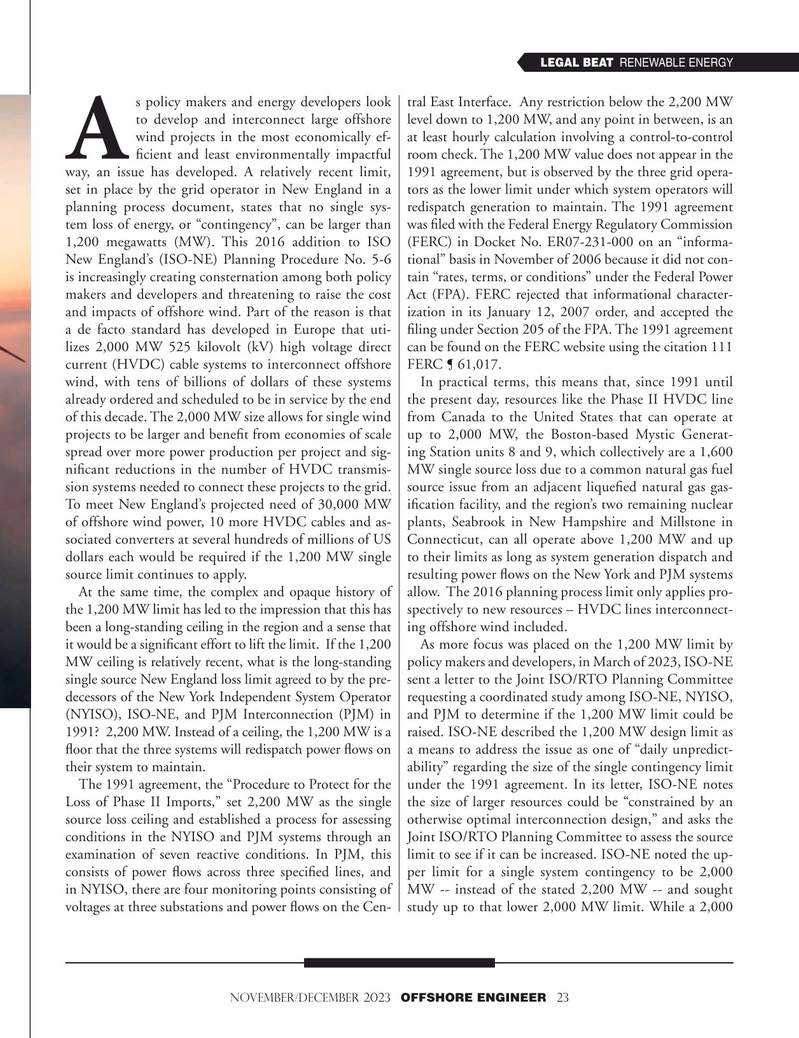
Page 23: of Offshore Engineer Magazine (Nov/Dec 2023)
Read this page in Pdf, Flash or Html5 edition of Nov/Dec 2023 Offshore Engineer Magazine
LEGAL BEAT RENEWABLE ENERGY s policy makers and energy developers look tral East Interface. Any restriction below the 2,200 MW to develop and interconnect large offshore level down to 1,200 MW, and any point in between, is an wind projects in the most economically ef- at least hourly calculation involving a control-to-control
A fcient and least environmentally impactful room check. The 1,200 MW value does not appear in the way, an issue has developed. A relatively recent limit, 1991 agreement, but is observed by the three grid opera- set in place by the grid operator in New England in a tors as the lower limit under which system operators will planning process document, states that no single sys- redispatch generation to maintain. The 1991 agreement tem loss of energy, or “contingency”, can be larger than was fled with the Federal Energy Regulatory Commission 1,200 megawatts (MW). This 2016 addition to ISO (FERC) in Docket No. ER07-231-000 on an “informa-
New England’s (ISO-NE) Planning Procedure No. 5-6 tional” basis in November of 2006 because it did not con- is increasingly creating consternation among both policy tain “rates, terms, or conditions” under the Federal Power makers and developers and threatening to raise the cost Act (FPA). FERC rejected that informational character- and impacts of offshore wind. Part of the reason is that ization in its January 12, 2007 order, and accepted the a de facto standard has developed in Europe that uti- fling under Section 205 of the FPA. The 1991 agreement lizes 2,000 MW 525 kilovolt (kV) high voltage direct can be found on the FERC website using the citation 111 current (HVDC) cable systems to interconnect offshore FERC ¶ 61,017. wind, with tens of billions of dollars of these systems In practical terms, this means that, since 1991 until already ordered and scheduled to be in service by the end the present day, resources like the Phase II HVDC line of this decade. The 2,000 MW size allows for single wind from Canada to the United States that can operate at projects to be larger and beneft from economies of scale up to 2,000 MW, the Boston-based Mystic Generat- spread over more power production per project and sig- ing Station units 8 and 9, which collectively are a 1,600 nifcant reductions in the number of HVDC transmis- MW single source loss due to a common natural gas fuel sion systems needed to connect these projects to the grid. source issue from an adjacent liquefed natural gas gas-
To meet New England’s projected need of 30,000 MW ifcation facility, and the region’s two remaining nuclear of offshore wind power, 10 more HVDC cables and as- plants, Seabrook in New Hampshire and Millstone in sociated converters at several hundreds of millions of US Connecticut, can all operate above 1,200 MW and up dollars each would be required if the 1,200 MW single to their limits as long as system generation dispatch and source limit continues to apply. resulting power fows on the New York and PJM systems
At the same time, the complex and opaque history of allow. The 2016 planning process limit only applies pro- the 1,200 MW limit has led to the impression that this has spectively to new resources – HVDC lines interconnect- been a long-standing ceiling in the region and a sense that ing offshore wind included. it would be a signifcant effort to lift the limit. If the 1,200 As more focus was placed on the 1,200 MW limit by
MW ceiling is relatively recent, what is the long-standing policy makers and developers, in March of 2023, ISO-NE single source New England loss limit agreed to by the pre- sent a letter to the Joint ISO/RTO Planning Committee decessors of the New York Independent System Operator requesting a coordinated study among ISO-NE, NYISO, (NYISO), ISO-NE, and PJM Interconnection (PJM) in and PJM to determine if the 1,200 MW limit could be 1991? 2,200 MW. Instead of a ceiling, the 1,200 MW is a raised. ISO-NE described the 1,200 MW design limit as foor that the three systems will redispatch power fows on a means to address the issue as one of “daily unpredict- their system to maintain. ability” regarding the size of the single contingency limit
The 1991 agreement, the “Procedure to Protect for the under the 1991 agreement. In its letter, ISO-NE notes
Loss of Phase II Imports,” set 2,200 MW as the single the size of larger resources could be “constrained by an source loss ceiling and established a process for assessing otherwise optimal interconnection design,” and asks the conditions in the NYISO and PJM systems through an Joint ISO/RTO Planning Committee to assess the source examination of seven reactive conditions. In PJM, this limit to see if it can be increased. ISO-NE noted the up- consists of power fows across three specifed lines, and per limit for a single system contingency to be 2,000 in NYISO, there are four monitoring points consisting of MW -- instead of the stated 2,200 MW -- and sought voltages at three substations and power fows on the Cen- study up to that lower 2,000 MW limit. While a 2,000 november/december 2023 OFFSHORE ENGINEER 23

 22
22

 24
24